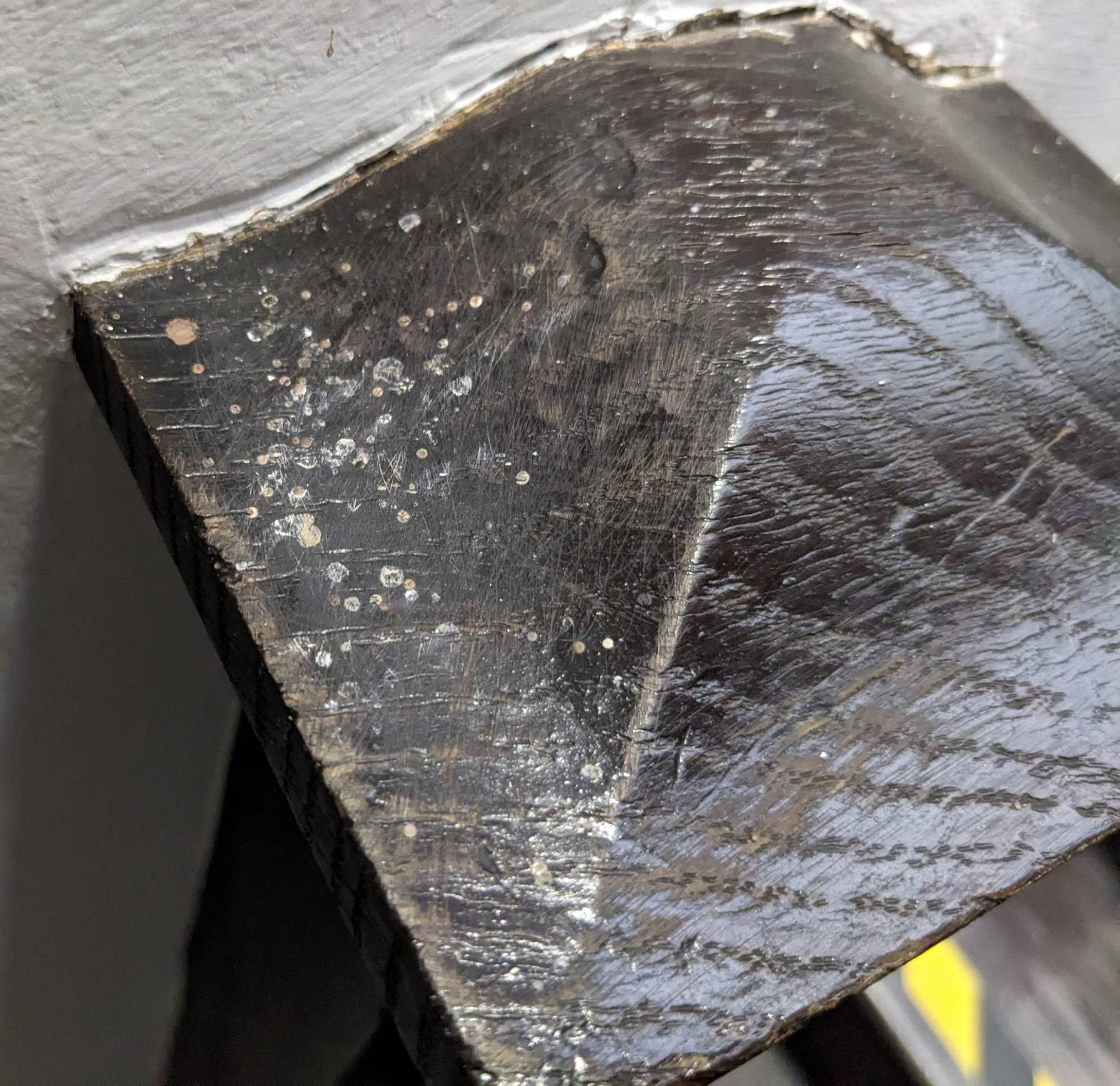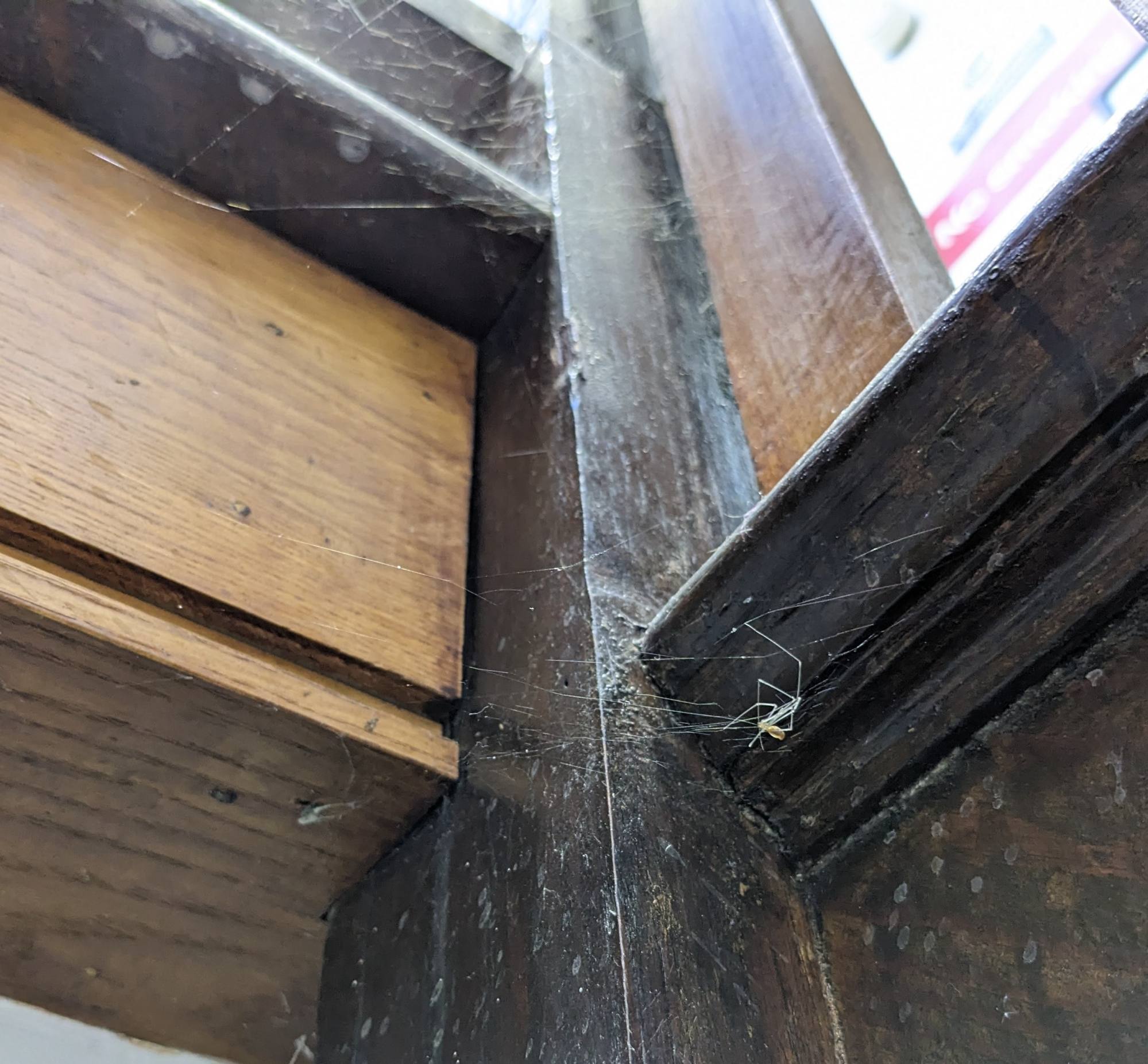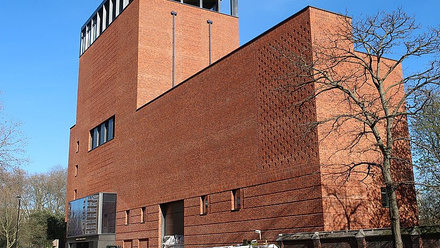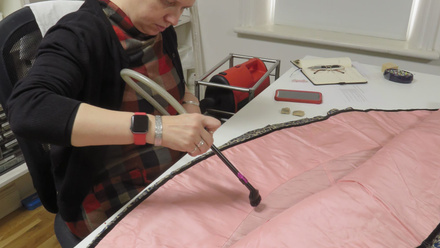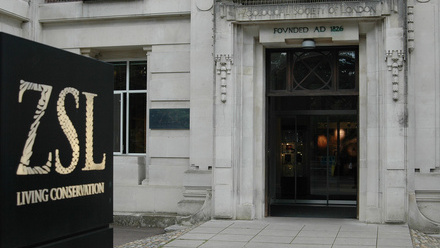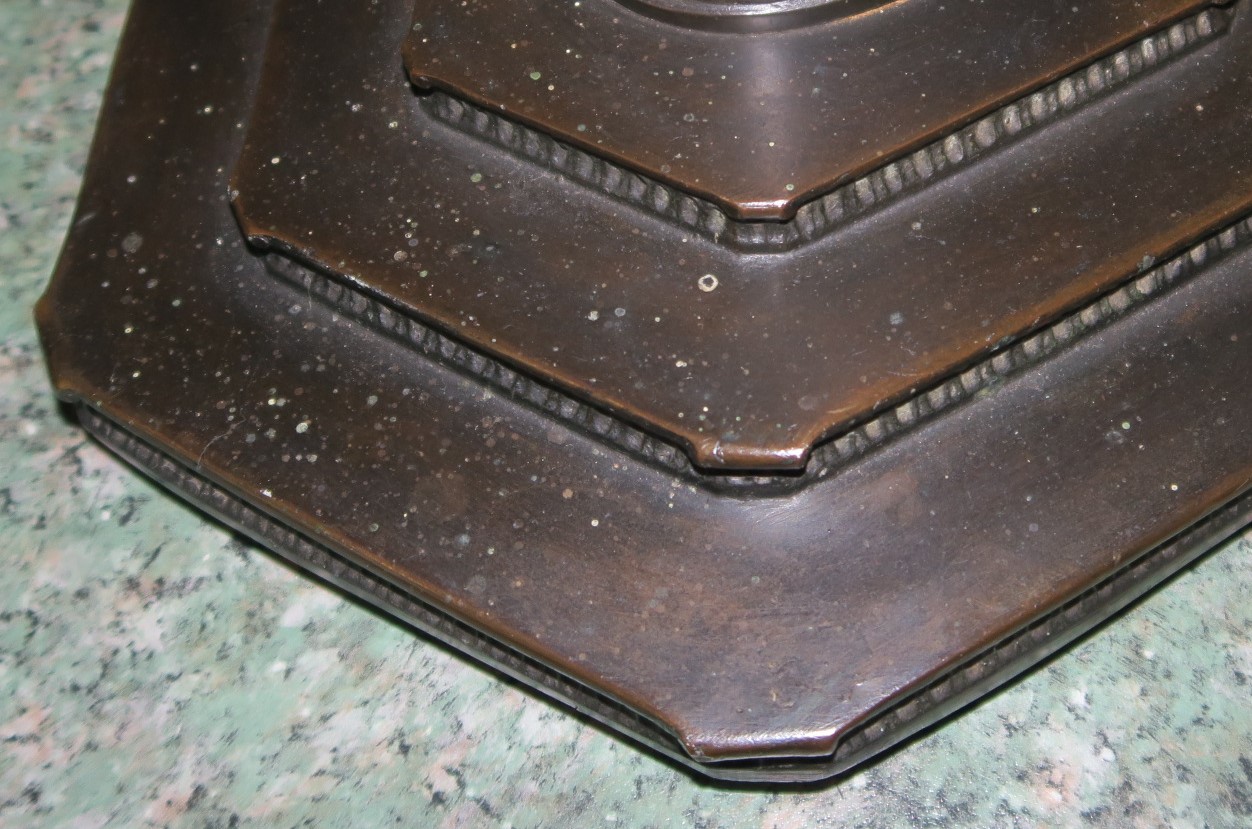
Example patinated bronze object before conservation displaying 'freckles' of possible spider excrement.
This brief article will take you through the effect of spider excrement to surface finishes on metal sculptures, focusing on a patinated bronze sculpture. With many Royal Collection objects on open display, it is inevitable that spiders will be present with predictable results. This article will describe what to look out for, how the excrement can affect the sculptures and what to do about it.
What is this all about?
Having conserved a wide range of sculptures from varying contexts with multiple materials including metals, wood and marble, I have experienced many objects with what I first assumed to be specks of white or light brown house paint splattered onto the surface. However, with most of the objects being transported to the workshop for conservation, it was challenging to assess exactly what the specks were.
When I began working on objects in situ, I was able to observe their surrounding environments. In almost all cases the positioning of the object meant that it was unlikely to be paint, but on one occasion I happened to look up above the object and saw a spider in its web. After this, I started looking everywhere and having seen the spots on the banister in the workshop, I looked up…
|
|
(Right) the culprit caught on camera
|
As entertaining as this may be, when it came to cleaning the white specs off metalwork sculpture using either deionised water, saliva on swabs or porcupine quills, the surface finish was always affected; the patina on bronze sculptures were discoloured exactly underneath where the white spec had been, or varnished wooden bases became matt and were flaking off where affected. Hence my investigation into this strange branch of my profession.
A word from other experts
I decided to reach out to the AIC Cons Dist List community to see if anyone else had come across this too.
I had varied responses, including a spider expert and Natural History Conservator who confirmed that spider excrement does contain small amounts of uric acid which also dries and “seals” the area.
Additionally, a senior conservation scientist from Indianapolis had come across a very similar situation in finding “white specks” on the base of a bronze sculpture.
They had also thought the specs could have been paint or possibly tin oxides from preferential corrosion of the bronze.
However, they conducted tests which revealed that the IR spectrum of the specs were organic and not latex paint.
Having also noticed the white specs under cobwebs, they harvested a sample under a web in a cupboard and got an exact spectrum match through FTIR analysis!
They did mention in their response that they had been previously told to differentiate between the white specks, associated with spiders, and brown/black specs to be associated with flies, another thing to keep in mind but still valuable information. Ideally, I would have liked to have done pH tests myself but unfortunately, I was not able to harvest enough material to create a viable result.
What to look out for
As mentioned previously, the excrements either spider or fly seem to resemble various sizes of ‘freckles’ or ‘specks’, white for spider and brown/black for flies.
In terms of the objects’ placement, sculptures placed within corners, on shelves or sills, or sculptures stored in areas where spiders are likely to make a home are all at risk.
Be sure to clear the webs above the objects as soon as you see them and evict the spider far from the property, otherwise they are likely to return. This is more difficult in large storage areas, but where pest control may not be viable for spiders and their webs, any objects not already in boxes or wrapped up should have some Tyvek placed over them.
How do the droppings affect the objects?
This article is purely produced from visual analysis from my worked experience.
Ideally it would be useful to test the pH of the droppings, what happens to the surfaces to the objects, how long can the droppings be left on in order for damage to occur, is excrement from some species more damaging than others, and so on. These are open for anyone for further investigation.
In some cases, the specks are easily removed using bamboo sticks, porcupine quills or saliva on cotton swabs; the dropping simply pinging off.
However, most of the time, when the specs are removed, they can also take the bronze patina with them. As well as this, they seem to penetrate through the protective wax layer, affecting the metal surface beneath.
From discussions with others on the Cons Dist List, you could assume that the slight acidity of the droppings can degrade and penetrate protective coatings, as well as bronze patinas.
As the droppings dry, they seal the affected area from the surrounding environment, causing colour change to the material underneath. Similar effects have also been found on varnished wooden bases to the sculptures I have worked on. When removed, the shine of the varnish is reduced.

Base of a bronze sculpture on open display, on a shelf in a corner with a web above it
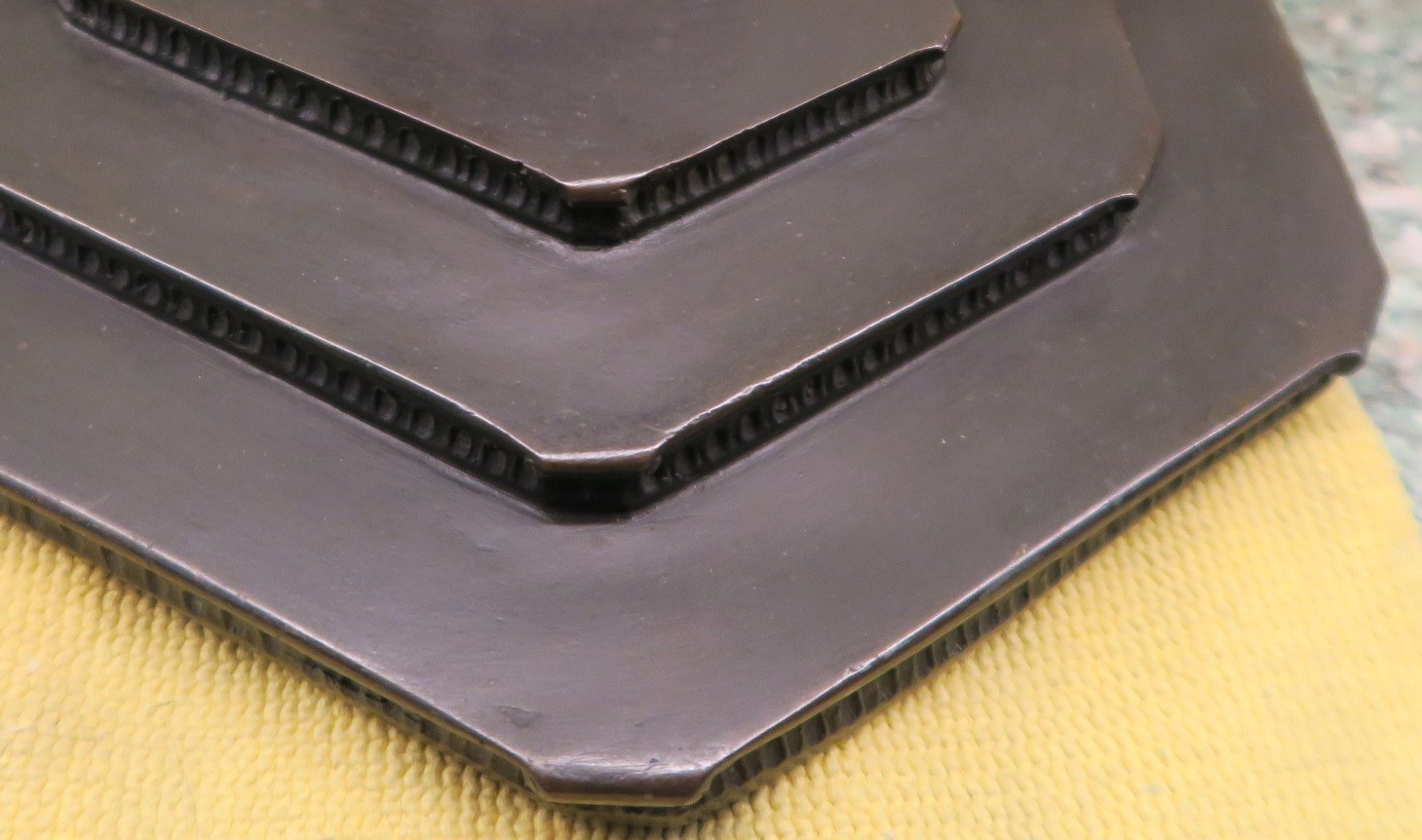
The object after conservation, where the specks were removed as far as possible and then coated with a tinted wax to unify the surface. The specks have caused a colour change to the surface, i.e. the patina has been changed, and are still visible even after being coated in a tinted wax.
What can we do?
Overall, here are some simple provisions to avoid the droppings affecting objects as far as possible, as mentioned previously:
- Keep objects covered if in storage
- Remove cobwebs as soon as you see them
- Evict the spiders far from the property if you can
- If you see white specs on an object, contact a conservator to have them removed and recoated where possible, and look above it to see if there are any webs
- Keep an eye on object placement within domestic environments; corners, shelves, sills
- Ideally, keep windows closed where necessary to avoid flies entering the property or install mesh screens and fly traps
Natasha Waddell
After completing my MA in Metalwork Conservation at West Dean College in September 2022, I began working as Assistant Metals Conservator for the Royal Collection Trust. My key responsibilities were conserving metal and composite objects ready for photography in preparation for the publication of a forthcoming catalogue raisonné of European sculpture, written by Jonathan Marsden. My career as an emerging conservator has progressed to becoming a free lance metals conservator based in Chichester, working in the South and South East region.

